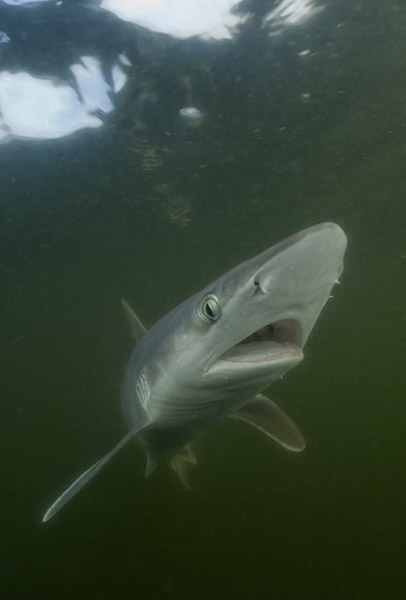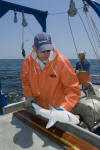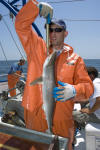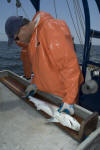|
The North American Shark Diving Tour - The Gulf First published in Shark Diver Magazine November 2009
The day after diving with silky sharks in Venice, we were scheduled to accompany Dr Eric Hoffmayer on a shark sampling expedition in the Mississippi Sound. Concerned that we would miss the boat, Claire and I dodged New Orleans and raced east through the night. As we approached Ocean Springs, the oppressive mugginess erupted with a deluge heavy enough to send our camper skidding around each greasy bend in the road. We joked about putting on our dive gear while the torrential rain, punctuated by a barrage of lightning bolts, hammered into the swamp land around us. Some hits were close enough to throw tree branches into the streets and I began to grow uneasy about the mountain bike, inadvertently doubling as a lightning rod, strapped to the roof of our van. I’m a little paranoid about lightning. A few years back, I was struck while riding a bicycle across Grand Cayman. It was a glancing blow that initially selected my right hand, pulling it skyward. Luckily, the actual bolt of electricity barely touched me as it slammed into the road next to me. Trying not to think about that experience, we pushed on towards town but eventually we were forced to take refuge under a gas station awning while the storm front passed us by. Claire dozed in the back and I sat staring out at the maelstrom wondering if all the run off would ruin tomorrow’s chances of seeing sharks. The next morning dawned clear. When we rolled up to the research vessel the crew was busy loading bait and equipment. We introduced ourselves to Dr Eric Hoffmayer who had graciously offered to let us tag along with his team of researchers in order to document their work and hopefully snap some images of Atlantic sharpnose sharks. Sharpnoses are relatively common in the northern Gulf of Mexico but they are so small and timid that divers never encounter them. We wanted to photograph a shark as it was being released which is probbly the only way to get a good i.d. shot of this particular species. Bleary eyed from the previous night’s adventures, I sat and listened to Eric talking about the relationship between sharpnose sharks, water temperature, salinity and hypoxia. Far from the stiff professorial demeanor that I had expected, Eric’s enthusiasm for sharks and willingness to share his wisdom soon pulled me out of my mental haze. He explained that male Atlantic sharpnose sharks migrate into the sound in early summer. This roughly coincides with rising water temps and dwindling freshwater outflow from the Mississippi Delta which leads to an increase in near shore salinity levels. Although the sharpnoses push far inshore they are relatively stenohaline - intolerant of brackish environments. The low oxygen levels in the sound are also a problem for the ram ventilating predators so the question that Eric would like to answer is why the little sharks bother coming into the sound at all. Female Atlantic sharpnoses usually stay in much deeper water so the males are definitely not there to mate. There is a reasonably abundant food supply but no more so that further out in the gulf and the extremely warm inshore waters cause the sharks’ metabolisms to speed up so much that they cannot consume enough food to keep up with their energy requirements. Consequently, by the end of the summer they have used up all of their energy reserves and their oil filled livers have shrunk to a third of their original size. Fishermen call the emaciated post-summer sharpnose sharks ‘wormies’. There are three primary factors that influence the movements of animals: food supply, reproduction and safety. Eric surmises that if it isn’t about the food or mating and the environment is physiologically detrimental to the shark’s health then they are probably migrating into the sound to hide. Atlantic sharpnose sharks are an important prey species for many of their larger cousins. Although bull sharks, blacktips and a number of other sharks follow the sharpnoses into shallow water, the sound is probably a far safer place for a 3ft shark than out in the clear, deep, shark infested waters of the gulf. Eric’s team set a long line with 100 baited hooks in 15ft of rust colored water. The sound looked utterly uninviting but Claire and I donned our suits anyway just incase Eric caught something for us to play with. The line was left marinating in the muddy bay for an hour then slowly reeled back in. The first few hooks came up bare but eventually a small shark broke the surface and thrashed until its whole body weight was suspended from the hook. Jill Hendon (Eric’s assistant) quickly dehooked the shark and took length and weight measurements and a fin clip for later DNA analysis. Eric then inserted a spaghetti tag that contained information about his lab and dropped the animal back into the soup. This process was repeated each time a live shark came up but that wasn’t always the case. Some came up disembodied from hungry but unseen bull sharks and many of the landed sharks were simply DOA; victims of shark research. I understand that this is a necessary evil in the collection of scientific data but I couldn’t do it. Fortunately my job has no such requirements. Eventually, Eric got a shark that was in great condition and Claire and I jumped in with it when it was ready to be released. I did a quick visibility check by holding out my arm and looking at my gloved hand. The water quality was so poor that I could barely see past my elbow and my hand was completely hidden. I soon realized that this was going to be practically impossible. Claire was gently holding the 2ft sharpnose and on my signal she released it right in front of me. I did my best to frame a few shots but there was so much silt in the water that my camera wouldn’t autofocus. The shark swam away and we climbed back onboard for a rethink. The researchers laid a total of four sets over the next couple of days and Claire and I played with different techniques to try to capture some publishable images. It was a strange and stressful adventure, not least because we could rarely see below our waists and we knew that there were bull sharks milling around in the darkness below us. Eventually it all worked out. Eric got some live Atlantic sharpnose images to illustrate his research, I got a new species for my field guide on Elasmodiver.com, Eli got this story for SDM and Claire got a nervous twitch (not really).
Author: Andy Murch Andy is a Photojournalist and outspoken conservationist specializing in images of sharks and rays.
RETURN TO SHARK STORIES MAIN PAGE
|






























